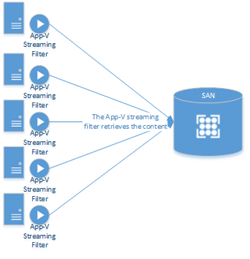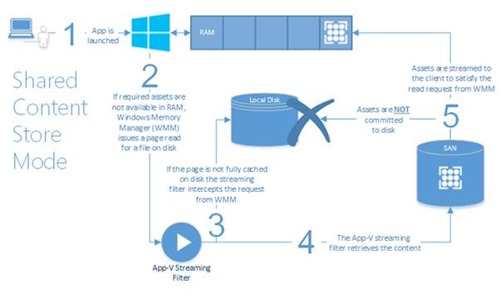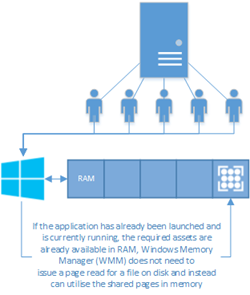Shared Content Store in Microsoft App-V 5.0 – Behind the Scenes
~ Thamim Karim | Premier Field Engineer
 Following on from my introduction to Shared Content Store (SCS) in this post I want to take you behind the scenes of what actually happens when we put our App-V 5.0 Client into this mode. The easiest way to understand how things work is by first looking at how things happen when launching an application for the first time in normal mode.
Following on from my introduction to Shared Content Store (SCS) in this post I want to take you behind the scenes of what actually happens when we put our App-V 5.0 Client into this mode. The easiest way to understand how things work is by first looking at how things happen when launching an application for the first time in normal mode.
Normal Mode (Default)
As you can see the first time the application is launched the App-V Streaming Filter interjects in order to provision the requested page to the client and in turn also commits that to the local disk within the cache. This means subsequent launches will not trigger any streaming of content as it will be held locally within cache. Now let’s take a look at how things how work when in Shared Content Store mode.
Shared Content Store
As you can see the only difference with Shared Content Store mode is that the assets are never committed onto the local disk. This means all subsequent launches will trigger the App-V Streaming Filter to intercept the page reads and stream the assets to the client. Therefore the assets of the application only ever reside in memory, the only part of the application that will be on disk is Feature Block 0, read more on that here.
Impact
When talking about SCS often questions are raised about impact and what additional overheads there are. The first thing to mention is that SCS is primarily designed for datacenter based solutions such as VDI/RDS environments, where fast connected storage is standard. Secondly as you have seen from the comparisons above, there is no actual overhead in terms of process, the only difference being that we do not commit to disk, in many environments this is a key benefit as it is helps to save premium disk space which would have otherwise been required to hold the App-V cache.
Multi-user
When talking about multi-user environments such as RDS where many users will be using the same platform at once, Windows Memory Management (WMM) will ensure efficiency of RAM usage for App-V applications as it would for any locally installed application. What this means is if one user is already using an App-V application, subsequent launches by other users on the same machine will not trigger multiple repeat streams of the content as WMM can utilize the shared pages already in memory. Read more about Windows Memory Management and how it works here.
In the above graphic we can take the example where one user logs on and launches a line of business application, every user thereafter who launches that same application does not cause WMM to trigger a page read from disk as the assets are already available as shared pages in RAM, therefore the streaming filter is not required to step in to retrieve the content.
Multi-machine
 The real impact to consider when utilizing SCS is the load on the storage solution itself.
The real impact to consider when utilizing SCS is the load on the storage solution itself.
In such scenarios you will have multiple clients requesting content from the content store in potentially a much more frequent and persistent fashion than you would have in normal mode.
Therefore it is important to test and size your backend storage provisioning sufficiently. The approach taken for this will differ vastly between environments and will depend on numerous factors such as connectivity, performance and content size.
Hybrid
There is of course the option to take a hybrid approach which means caching certain applications locally and letting SCS dynamically stream the remaining applications. For example you could put your client into SCS mode and mount your LOB applications locally using the Mount-AppvClientPackage PowerShell command.
Thamim Karim | Premier Field Engineer | Microsoft
Get the latest System Center news on Facebook and Twitter :
System Center All Up: https://blogs.technet.com/b/systemcenter/
System Center – Configuration Manager Support Team blog: https://blogs.technet.com/configurationmgr/
System Center – Data Protection Manager Team blog: https://blogs.technet.com/dpm/
System Center – Orchestrator Support Team blog: https://blogs.technet.com/b/orchestrator/
System Center – Operations Manager Team blog: https://blogs.technet.com/momteam/
System Center – Service Manager Team blog: https://blogs.technet.com/b/servicemanager
System Center – Virtual Machine Manager Team blog: https://blogs.technet.com/scvmm
Windows Intune: https://blogs.technet.com/b/windowsintune/
WSUS Support Team blog: https://blogs.technet.com/sus/
The AD RMS blog: https://blogs.technet.com/b/rmssupp/
App-V Team blog: https://blogs.technet.com/appv/
MED-V Team blog: https://blogs.technet.com/medv/
Server App-V Team blog: https://blogs.technet.com/b/serverappv
The Forefront Endpoint Protection blog : https://blogs.technet.com/b/clientsecurity/
The Forefront Identity Manager blog : https://blogs.msdn.com/b/ms-identity-support/
The Forefront TMG blog: https://blogs.technet.com/b/isablog/
The Forefront UAG blog: https://blogs.technet.com/b/edgeaccessblog/
Comments
Anonymous
January 01, 2003
Thanks!Anonymous
August 13, 2013
Good post.Anonymous
October 18, 2013
When using scs on vdi/rds especially on rds the memory sizeing on the rds host is important aswell. If you have lots of applications and lots of users on a rds host you need to have memory enough to cache all those apps in the WMM. If not its goin to re-read the data from the content store. So if you dont have enough RAM on your servers its going to be a massive impact on the SAN. Correct? So on a RDS host, wouldnt it be cheaper to provision a "appv cache" disk residing on local disk if its virtualized or just use local disk if its not virtualized? And you would get faster starting times aswell for larger apps if you precache them. Or am i missing something?Anonymous
October 30, 2013
Hi there, I understand where you are coming from. I guess it all depends on what the impact to the SAN is, in many scenarios they are just as if not more efficient as locally attached disks, infact in some environments the storage will be physically enclosed in the blade chassis with the server servers themselves. RAM sizing is relevant but SCS shouldn't mean you aim to always read from RAM, SCS is designed to stream into RAM and the impact of this should be understood. I do agree in some scenarios where the SAN is not efficiently able to handle this impact a local cache may be preferable.Anonymous
March 24, 2014
Thanks for Information. Please provide more information on Hybrid part.I have 2 types of RDS APPV package. Least used applications and most used applications. for which category applications, Enabling SCS helps?Anonymous
April 11, 2014
Shared Content Store is proving a very popular feature with App-V 5.0 and with my recent post on TheAnonymous
May 07, 2014
Hi, on an RDS (Citrix) system, is the WMM feature something new to AppV 5 or did AppV 4 already use this sharing of memory?
When testing this scenario on a system with a second user I however cannot reproduce this. The second user who launches an application already started by the first user will again increase the total memory usage. Where can I find more information about the WMM on AppV?Anonymous
June 17, 2014
Hi Karim, what would be the exact impact of using SCS in an SCCM 2012 scenario? The way I see it, SCCM will store the App-V locally anyhow (under ccmcache), and the App-V Streaming Filter will stream it from there - you do save 50% of disk space, but you still end up with the local SCCM cahce. Am I correct in assuming this?
Cheers,
JonasAnonymous
June 17, 2014
The comment has been removedAnonymous
February 10, 2016
Thamim,
I have a VMware APPV5 package that will deploy to machines, however this will be confusing to VDI users when they see this. Is there any feature or setting to disable the package from going into Share Content Storage ?
thanks,
Matt




